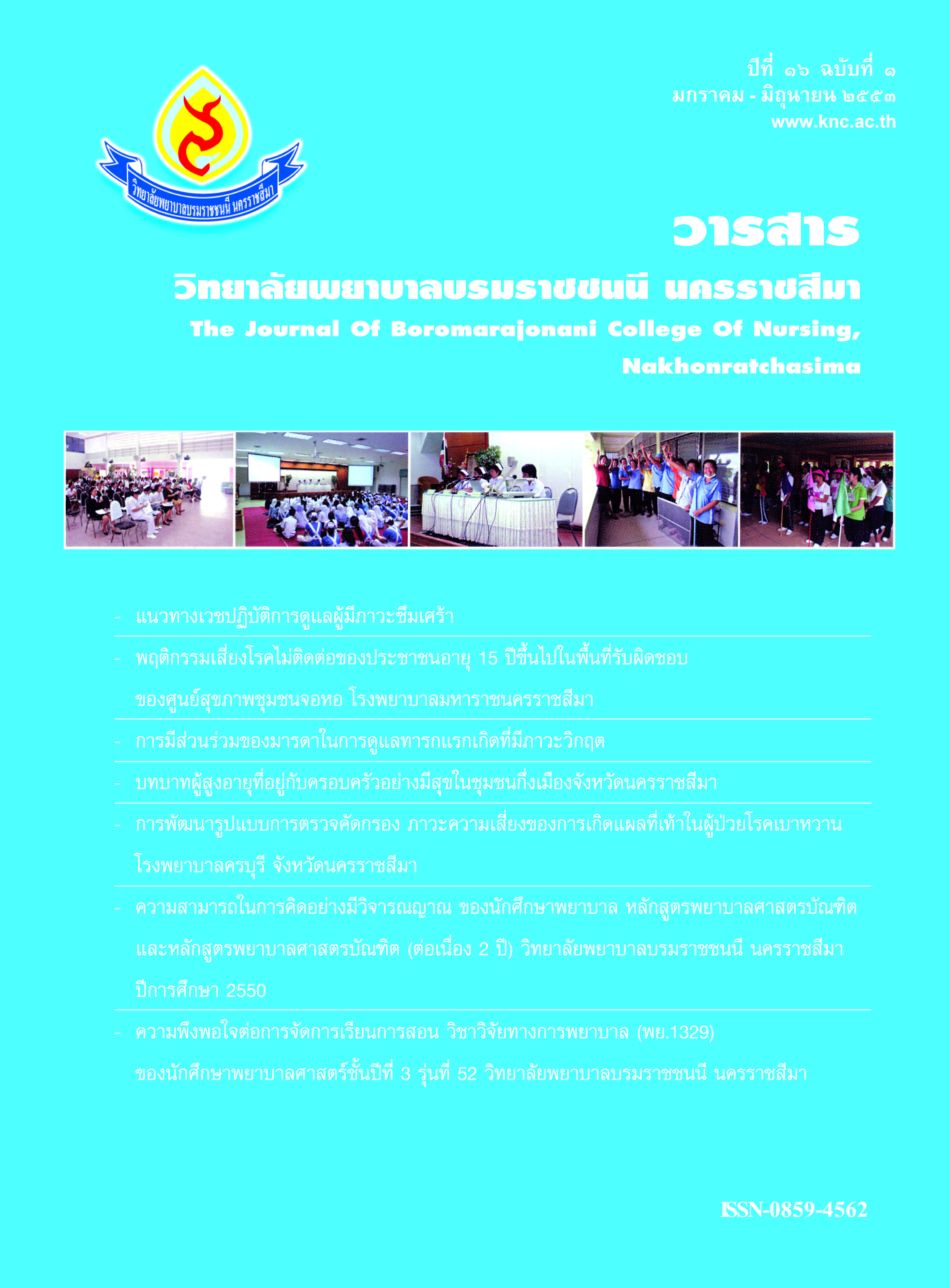การมีส่วนร่วมของมารดาในการดูแลทารกแรกเกิดที่มีภาวะวิกฤต
คำสำคัญ:
การมีส่วนร่วม, การดูแล, ทารกแรกเกิดที่มีภาวะวิกฤต, participation, caring, high-risk neonateบทคัดย่อ
บทคัดย่อ
การวิจัยครั้งนี้ เพื่อศึกษาเปรียบเทียบการมีส่วนร่วมของมารดาในการดูแลทารกแรกเกิดที่มีภาวะวิกฤต ตามความเห็นของมารดาและพยาบาล กลุ่มตัวอย่างที่ใช้ในการศึกษามี 2 กลุ่ม ได้แก่ 1) มารดาของทารกแรกเกิดที่มีภาวะวิกฤตที่เข้ารับการรักษาในหอผู้ป่วยหนักทารกแรกเกิด โรงพยาบาลมหาราชนครราชสีมา 2) พยาบาลผู้ให้การดูแลในหอผู้ป่วยหนักทารกแรกเกิด ผลการศึกษา พบว่า 1) มารดาคิดว่าตนมีส่วนร่วมในการดูแลทารกแรกเกิดที่มีภาวะวิกฤต น้อยกว่าที่ต้องการปฏิบัติ อย่างมีนัยสำคัญทางสถิติที่ระดับ .001 2) พยาบาลคิดว่ามารดามีส่วนร่วมในการดูแลทารกแรกเกิดที่มีภาวะวิกฤตน้อยกว่าที่พยาบาลต้องการ อย่างมีนัยสำคัญทางสถิติที่ระดับ .001 3) การมีส่วนร่วมของมารดาในการดูแลทารกแรกเกิดที่มีภาวะวิกฤตที่มารดาปฏิบัติจริงตามความเห็นของมารดา น้อยกว่าความเห็นของพยาบาลอย่างมีนัยสำคัญทางสถิติที่ระดับ .01 4) การมีส่วนร่วมของมารดาในการดูแลทารกแรกเกิดที่มีภาวะวิกฤตที่มารดาต้องการปฏิบัติ มากกว่าที่พยาบาลต้องการให้มารดาปฏิบัติอย่างมีนัยสำคัญทางสถิติที่ระดับ .001 ผลการศึกษา เสนอแนะว่า พยาบาลควรทราบความต้องการ การมีส่วนร่วมของมารดาในการดูแลทารกแรกเกิดที่มีภาวะวิกฤต เพื่อนำข้อมูลมาใช้ในการวางแผนปฏิบัติการพยาบาลที่ส่งเสริมให้มารดามีส่วนร่วมในการดูแลทารกแรกเกิดที่มีภาวะวิกฤตตรงตามความต้องการของมารดา และช่วยในการกำหนดบทบาทของมารดาและพยาบาลในการร่วมกันดูแลทารกได้สอดคล้องกับความต้องการของมารดา
คำสำคัญ : การมีส่วนร่วม, การดูแล, ทารกแรกเกิดที่มีภาวะวิกฤต
Abstract
The aims of this study were to describe maternal participation in caring for their high-risk neonates. Forty mothers of high-risk neonates and twenty registered nurses at a neonatal intensive care unit (NICU) of Maharaj Hospital, Nakhonratchasima Province were participants in this study. The data were collected by two sets of questionnaires. Three questionnaires were for the mothers and two questionnaires for the register nurses to complete. The personal and general data were analysed by descriptive statistics and paired t-tests were used to compare mean differences between the mothers’ and the nurses’ perceptions of the actual and expected maternal participation in caring, and also to compare the mean differences between mothers’ and nurses’ perceptions. According to the study, the mothers’ perception of their actual participation in caring for their babies was less than their expectation (p = < .001). The nurses’ perception of actual mothers’ participation in caring for their babies was less than nurses’ expectation (p = < .001). The mean of actual maternal participation in caring for high-risk neonates from the mothers’ perspectives was lower than the nurses’ perception (p = < .01). The mean of expected maternal participation in caring for high-risk neonates from the mothers’ perspectives was higher than the nurses’ perspectives (p = < .001). The results indicated that the mothers of high-risk neonates needed to participate in caring for their babies more than they has done. The mean of the mothers’ perception and nurses’ perception was also significantly different. Nurses should explore the mothers needs of caring collaboration and promote maternal participation which could start from listening to the mothers’ needs about caring for the high-risk neonates who attend at the intensive care unit. This can ensure that the nursing care plan meet the needs and expectation of the mothers in caring for high-risk neonates.
Keywords : participation, caring, high-risk neonate
Downloads
ฉบับ
บท
License
บทความที่ได้รับการตีพิมพ์เป็นลิขสิทธิ์ของ วารสารสุขภาพและการศึกษาพยาบาล ซึ่งดำเนินการโดยวิทยาลัยพยาบาลบรมราชชนนี นครราชสีมา
ข้อความที่ปรากฏในบทความในวารสารเล่มนี้เป็นความคิดเห็นส่วนตัวของผู้เขียนแต่ละท่านไม่เกี่ยวข้องกับกองบรรณาธิการวารสารสุขภาพและการศึกษาพยาบาล หรือวิทยาลัยพยาบาลบรมราชชนนี นครราชสีมา แต่อย่างใด ความรับผิดชอบองค์ประกอบทั้งหมดของบทความแต่ละเรื่องเป็นของผู้เขียนแต่ละท่าน หากมีความผิดพลาดใดๆ ผู้เขียนแต่ละท่านจะรับผิดชอบบทความของตนเองแต่ผู้เดียว






